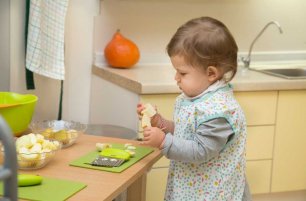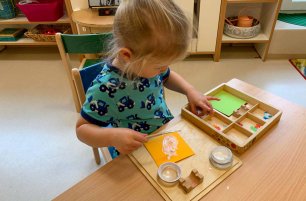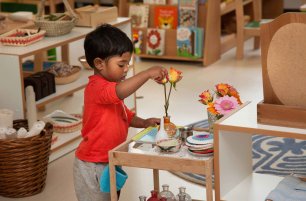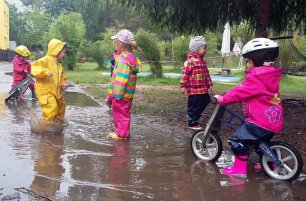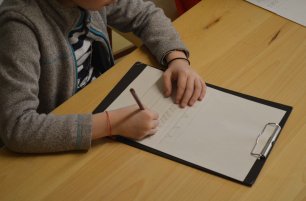Toilet Training: A Key How to Succeed
How to handle toilet training? It’s often considered one of the first big parenting “tasks,” and can bring a lot of anxiety and frustration. But it doesn’t have to! In Montessori Infant and Toddler classrooms, we use a time-tested and practical approach to toilet training that is (dare I say it) easy on both parents and children.
What does actually a Toilet Training mean?
Let’s start with a few definitions. Toilet training is the process of learning to control your body so as to “go” into a potty or a toilet, rather than involuntarily, into a diaper. People are born without the capacity to accomplish this. It’s not just that the newborn child can’t walk to the toilet, or doesn’t understand why they should want to: infants also don’t have the neurological development necessary to control this part of the body. Physiologically, children usually become capable of both holding and releasing urine and bowel movements during the second half of their first year – right around the time they get very mobile, sit and crawl well, and begin to stand up.
Motivation to “hold it” – how to develop it?
Of course, physiology is just the start. Next comes the trickier bit: for the child to understand their bodily functions and develop the motivation to control them. Understanding comes from experience and becoming acquainted with one’s own body. Children tend to toilet train faster if they had been spending time without a diaper, if they had used cloth diapers over disposables at least part-time (as they offer much more physical feedback than our ultra-dry-touch modern inventions), and if their caregivers explained and described things to them during diaper changes.

Motivation is by far the trickiest part
All too often, adults resort to bribes, praise or punishments to “motivate” a child to toilet train, unnecessarily and often counterproductively – after all, a child who is anxious to disappoint or displease their parents is much more likely to have a nervous accident. Please avoid this mistake! All the motivation a child needs is innate: many children will find being wet uncomfortable, it means stopping play in order to go wash and change, and most of all they want to be “like their parents”.
All too often, once we as adults decide that “it is time” to toilet train, we feel that we need to somehow make this happen - and resort to bribes, praise or punishments to “motivate” a child. This is unnecessary and usually counterproductive. A child who is anxious to disappoint their parents is much more likely to have a nervous accident; meanwhile, a toddler who is feeling contrary and trying to exert some control over their family will find this a prime opportunity to make their parents run around and act all kinds of funny.
All the motivation a child needs to toilet train is innate: a child wants to be like us, wants to act grown up and do things like their parents and caregivers do. Plus, once we take diapers off, most toddlers will want to be comfortable in their dry underwear. Having an accident feels wet and unpleasant, it means we have to go wash and change. A toddler will soon figure out that using the potty properly is faster and easier all around.
So how do we go about things?
-
As soon as your child is able to stand, change diapers standing up (it is perfectly possible to manage with soiled diapers, but if you don’t trust me, at least try it with wet ones) rather than lying down. This allows the child a much more direct view and understanding of what is happening, as well as possibility to actively participate: they can help you pull the diaper up and down, and help dressing and undressing.
-
During each diaper change, sit your child on the potty. This can be just for a few seconds as you’re putting a wet diaper away and getting a clean one. At first, you just want to get them used to the idea of sitting on this strange thing with a hole in it. You can point out that a potty is akin to the big toilet you use, and if your child comes to you to the bathroom (congratulations if they don’t!), explain what you’re doing, too! Now wait…
-
Your child will pee in the potty – quite by accident, most likely. Probably they will be delighted and intrigued by this thing their body did. Acknowledge that it happened and name it for them – “I see, you peed in the potty” – but we strongly recommend you don’t praise or celebrate in front of your child.
-
Once you see that your child got the idea – you will know when this happens, usually after pee ends up in the potty a few times – introduce time without diapers. Underwear is a great natural motivation, as most young toddlers are excited to wear it. Many parents also choose to do this in the summer when the weather cooperates and we are outside a lot, although it is perfectly possible to toilet train in the middle of the winter, too. Now, stand at the ready with some cleaner and towels, because...
-
Your child will have an accident. “Oh, look, your pants are wet. I see that you peed.” Acknowledge and explain what happened, and have them sit on the potty: it is important to establish this connection, even if you know that they don’t have anything left in them. Afterwards, have your child assist with the clean up – even if it’s only by taking their wet pants to the washing machine or handing you a paper towel. The idea is that they will be involved rather than off to play as you clean, and you’ll have more opportunity to establish and explain the natural consequence: you pee in your pants, you’re wet.
And that – actually – is it. Lather, rinse, repeat. Trust me, it will work. Depending on your child’s personality, more than anything else, it will work over a few days or a few weeks; if you go very slow, even a month or two. Of course, you might not be able to quit diapers altogether - car seats, long trips, even outside time in cold weather might mean putting them back on: do what you can. The more consistent you can be, the more learning opportunities your child gets, the faster you’ll be done. Some puddles will happen, but likely not as many as you may think: consider them a worthy investment into having your child out of diapers and into this next stage of their independence.
What about bowel movements? The underlying principle is the same, but pooping in the potty usually comes well after successfully peeing in one; after all, there is much less practice, and the process can be more difficult and uncomfortable. In children who are potty trained later, after age two, it is quite common for them to be resistant: some children continue to ask for diapers, want to hold your hand or kick you out of the room for absolute privacy, or set other special conditions. This is fine and usually just needs our patience as it resolves itself. Most toddlers are pretty regular, so you can encourage them to sit on the potty when you know they need to go, but don’t push - it’s perfectly fine to give a diaper to a child who asks for it so that they can poop. If nothing else, it is a proof of their awareness of and control over the process. The last thing you want is to let them work themselves up into constipation, which is so easy for a toddler to do! And, if your toddler gets overly upset about pooping, watch their fiber and water intake so make sure everything is as painless - literally - as it can be.
A Few Practical Notes
Selecting a potty
Please avoid all the light-up, music playing inventions – all that’s needed is a stable, non-slip, easy-to-clean model (an inset that can be lifted up is great for not spilling pee when you’re emptying it). Likewise, it’s not actually necessary to have more than one – we recommend placing it in the bathroom, or if that’s not practical, in the child’s bedroom - again, you want to set up the understanding and expectation that there’s a special place where we go to pee.
Dress for success
For this stage, if you can, avoid adorable lace-trim dresses, overalls, onesies or items with complicated fastenings and snaps. Settle for outfits that come on and (more importantly) off quickly and easily: elastic waist sweatpants or leggings, undershirts and tshirts. We can also recommend so-called training pants: this is simply thick, padded underwear with an absorbent layer. It is not waterproof and you’ll still need to to deal with wet pants - but, hopefully, not with shoes full of pee and a puddle on the floor.
“I don’t need to go!”
The time will come when you can trust your child on this, but that is likely far off in the future. Meanwhile, you want to respect their agency and also avoid another puddle or a dash to the bathroom five minutes later. We recommend a simple workaround: tell your child that they don’t have to pee (perhaps they don’t!) but they have to sit on the potty. Before leaving the house, after getting up from bed… You can set a timer, put a book to flip through, whatever it takes to keep your child seated for a few moments. That way you’re not arguing with anyone about the state of their bladder, you’re simply giving them the opportunity to relieve it.
Take notes!
If you’re struggling, you can write down when your child fills their diaper, and then later on, whenever they have an accident. You might see a pattern emerge that will allow you to predict when exactly to put them on the potty. This can be especially helpful with a toddler struggling to use the potty for bowel movements.
Sleep
The ability to stay dry at night usually develops anytime between two and six years of age. There’s no rushing it - some children stay dry earlier, some later, and there’s literally nothing we can do to predict or control it. There’s nothing wrong with using sleep diapers long after you have toilet training down during the day. However, do bring it up with a pediatrician if your child still wets themselves in bed around age six, in case there is an underlying physiological issue, and please know that it is a case for concern - physiological or more often psychological - if bedwetting returns after a prolonged period of dryness.
By Michaela Tučková / Toddler Teacher
Want to learn more? Read our next article:
